Sissi – Fateful Years of an Empress Blu-ray Movie
HomeSissi – Fateful Years of an Empress Blu-ray Movie 
Sissi - Schicksalsjahre einer KaiserinFilm Movement | 1957 | 109 min | Not rated | Early 2017
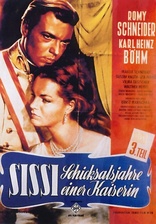
Price
Movie rating
6.9 | / 10 |
Blu-ray rating
| Users | 0.0 | |
| Reviewer | 3.5 | |
| Overall | 3.5 |
Overview
Sissi – Fateful Years of an Empress (1957)
The final film in a highly romanticized trilogy about Elisabeth "Sissi" of Austria finds the young empress traveling throughout Europe.
Starring: Romy Schneider, Karlheinz Böhm, Magda Schneider, Gustav Knuth, Uta FranzDirector: Ernst Marischka
| Romance | Uncertain |
| History | Uncertain |
| Foreign | Uncertain |
| Drama | Uncertain |
Specifications
Video
Video codec: MPEG-4 AVC
Video resolution: 1080p
Aspect ratio: 1.78:1, 1.33:1
Original aspect ratio: 1.37:1
Audio
German: DTS-HD Master Audio 5.1
Subtitles
English
Discs
Blu-ray Disc
Single disc (1 BD)
Playback
Region A (B, C untested)
Review
Rating summary
| Movie | 3.5 | |
| Video | 4.0 | |
| Audio | 3.5 | |
| Extras | 0.0 | |
| Overall | 3.5 |
Sissi – Fateful Years of an Empress Blu-ray Movie Review
Reviewed by Jeffrey Kauffman November 7, 2017Note: This film is available as a part of
The Sissi Collection.
Peter O’Toole will enter the cinematic record books for any number of reasons, including the fact that he remains one of the most Oscar nominated
actors to never receive an “official” award (O’Toole was feted with an honorary Academy Award in 2003, perhaps precisely because he had
never “really” won). O’Toole’s second and third nominations for Best Actor made history in a different way, for in 1964’s Becket and 1968’s The Lion in Winter, O’Toole was playing the same real life historical character (at different ages), King Henry II. There
have been at least a few other performers who have played the same character in different films, and some of them, like Bing Crosby in Going My Way and The Bells of St. Mary's, or Al Pacino, in The
Godfather and The Godfather: Part II, have also
garnered Oscar nominations for each film, like O'Toole, though by and large those performances have been of fictional characters. One of the few
other
times the same performer has played the same real life historical character in otherwise unrelated films was when Romy Schneider "recreated" her
take on Empress Elisabeth of Austria for Luchino Visconti's Ludwig
, years after she had taken on the same role in a series of films that became known as The Sissi Trilogy ("Sissi" was the diminutive
nickname family members called Elisabeth). This in and of itself is kind of a fascinating "trivia" phenomenon, since I personally can't think of
another example where one performer essayed a role based on a real life historical figure in a "series" and then played the same role years later in
a completely unrelated film. There are of course other manifest differences between the series and the Visconti film, due not just to the different
eras in which they were produced, but also due to the fact that Ludwig is an often provocative, even trenchant, entry, while all three
Sissi films tend to exploit a glossy quasi-"Hollywood" style where happily ever after is never too far out of reach.
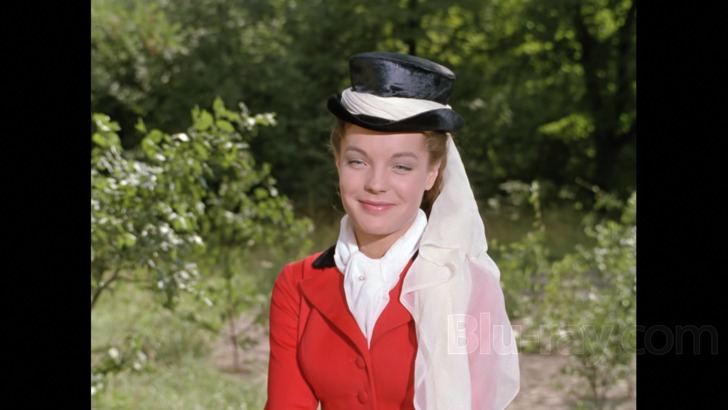
In some ways Sissi — Fateful Years of an Empress is the most interesting of all three of the Sissi films, since it manages to rather artfully combine both the personal and the “processional” (as in the day to day lives of the royal class). Once again, as in Sissi - The Young Empress, there’s simmering discontent between Sissi and her mother-in-law Sophie (Vilma Degischer), something that informs the underlying plot of this entry and which provides a truly cathartic emotional moment late in the film, but in other ways Sissi — Fateful Years of an Empress derives a lot of its power from more “communal” issues, including political movements that were afoot at the time and the disconnect between the nobility and “everyday” folks.
This third entry develops Sissi’s relationship with Hungary, and (not so coincidentally) with Count Andrássy (Walther Reyer), who obviously has eyes for Sissi, and whose involvement with her gives the ever machinating Sophie “talking points” to start spreading gossip. Things between Sissi and her mother-in-law reach a breaking point when Sissi is diagnosed with a “mystery” illness (which seems to be tuberculosis), leading to a disruption of the family unit which provides some surprising emotion, at least considering the kind of “distant” feeling the first two films frequently had in terms of any genuine human feeling.
I’d in fact rate the third Sissi film as overall the most generally effective of the three, even as it once again tries to shoehorn supposedly “historical” events into the framework developed in the first film. Part of what makes this particular entry work is its allusions to some of the socioeconomic issues which were at play during this general era, and that acknowledgement that not everyone was dressed to the nines and enjoying palatial stomping grounds gives this film a bit of subtext that the two others don’t have. Make no mistake — this is not Les Misérables in any way, shape, or form, but there is at least relatively speaking a bit more realistic mien to this film than its predecessors.
Sissi – Fateful Years of an Empress Blu-ray Movie, Video Quality 
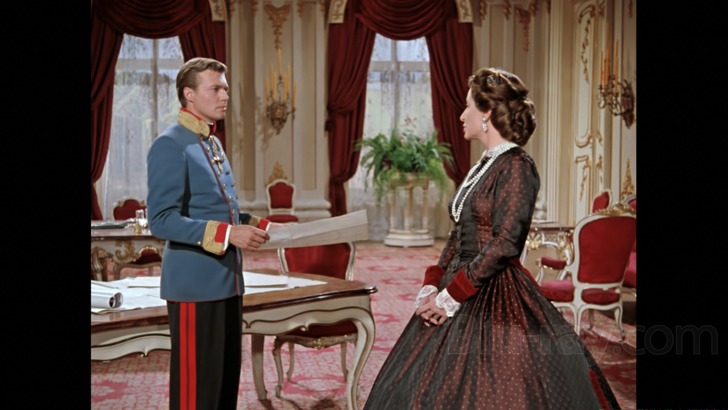
All three of the Sissi films in The Sissi Collection
are presented on Blu-ray courtesy of Film Movement with AVC encoded 1080p transfers in both 1.33:1 and 1.78:1 in what Film Movement is
touting as new 2K restorations (without stating what exactly was the source for the restorations). All three films feature an announcement that they
have been digitally remastered by Arri Film and Television Restoration Services and Taurus Media Digital. Because all three share certain
similarities, I'll deal with them as a group before moving on to comments about each
film separately. Perhaps surprisingly, given the era in which they were shot, all three were evidently originally released in Academy Ratio, despite
the
fact that the "widescreen" rage had already erupted on this side of the pond. Therefore, most of the screenshots I've included with each review
feature
that aspect ratio, but I have also included a few of the "rejiggered" 1.78:1 versions so that those interested can see the differences in framing. One
of
the most noticeable differences is not in fact with regard to framing but with regard to the appearance of grain, which is much more substantially
noticeable in the 1.78:1 versions, I assume due to being blown up and cropped to fit that aspect ratio. All three films were shot using the German
Agfacolor process, a technique that is manifestly different looking than "classic" Technicolor. If "Technicolor reds" might be thought of as one of the
defining characteristics of that technology, I'd argue that "Agfacolor blues" might be a corollary for this particular process. Otherwise, Agfacolor can
look just a little anemic, at least relative to Golden Age Technicolor, with reds tending to skew a bit toward the pink or orange side of things and the
overall palette never looking quite as richly suffused as in traditional Technicolor outings. The restorations are by and large quite winning, though
eagle
eyed viewers may still catch a stray (minor) blemish or two that peeks through now and again. Detail levels are a little variable, with all three films
looking a bit on the soft side. At times even midrange shots tend to look a bit "blurry" in terms of things like facial details. That said, in close-ups,
fine
detail on elements like the opulent costumes and sets can be excellent. While there is a fine grain field in the 1.33:1 versions, things look just
slightly
digital to my eyes, with perhaps some high frequency filtering having been applied, since the grain field is somewhat variable and tends to look
unnatural at times.
The third Sissi film exhibits some of the same kind of odd anomalies with regard to grain resolution that the two other films do, but on the
whole I'd say this presentation is generally probably the most consistently organic looking (though, again, freeze framing at any given moment can
show that same "airbrushed" quality to certain sections of any individual frame). The entire palette in this film seems intentionally toned down from
the first two films, with the bulk of costumes tending to exploit paler pastels rather than any bright primaries (even with regard to Franz Joseph's
blue uniform), and as such, things can look a bit on the pallid side. Once again fine detail looks rather good in close-ups, helping to delineate
elements like the fine beaded brocade on one of Sissi's opulent gowns, or (in what seems to be a recurring issue with the costuming in this film)
some of the feathered hats various characters (both male and female) wear.
Sissi – Fateful Years of an Empress Blu-ray Movie, Audio Quality 
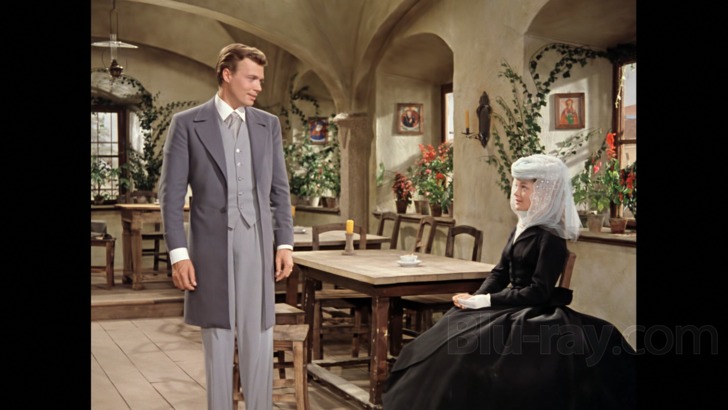
All three of the Sissi films feature DTS-HD Master Audio 5.1 and Dolby Digital 5.1 mixes in the original German. Why these have not been offered with the original mono tracks is unfortunate, since aside from some age related issues like overall boxiness, there are recurrent prioritization issues in all three films that sounded decidedly unnatural to my ears. For example, sound effects like squawking geese or galloping horse hooves can occasionally overwhelm dialogue. The "surround" activity in these mixes is intermittent at best and at worst tends to add too much reverb (for my ears, anyway), leading to a somewhat diffuse sound. There is minor distortion in all three films with regard to some of the music, especially in terms of the more blaring brass or higher string sounds. Dialogue generally comes through fine, with the exception of the aforementioned prioritization issues.
Sissi – Fateful Years of an Empress Blu-ray Movie, Special Features and Extras 
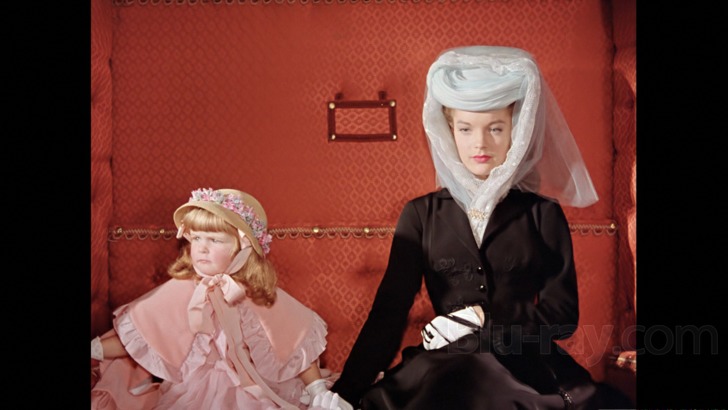
While there are some supplements included in this package, none are on this particular disc. See our The Sissi Collection Blu-ray review for details.
Sissi – Fateful Years of an Empress Blu-ray Movie, Overall Score and Recommendation 
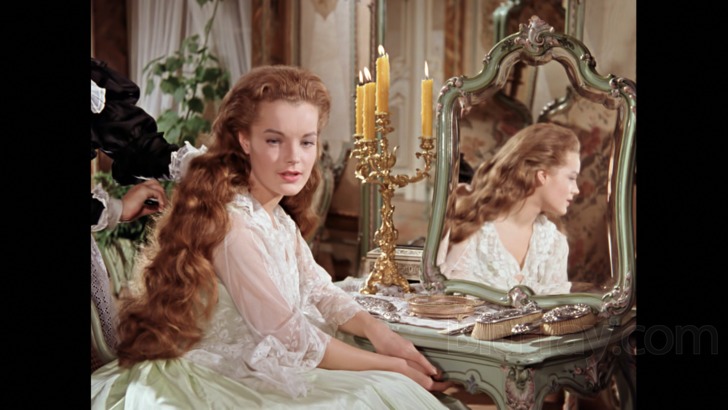
Sissi — Fateful Years of an Empress forsakes some of the more syrupy aspects of the first two film to provide some almost realistic feeling emotion in terms of Sissi's relationship with her mother-in-law and the disruption of her family life once she becomes ill. That, combined with at least allusions to the "common" people, help to make this third film more emotionally resonant than the first two. Technical merits fall in line with all the films in this set, for better and worse. Recommended.
Similar titles
Similar titles you might also like
(Still not reliable for this title)

Sissi - The Young Empress
Sissi - Die junge Kaiserin
1956

Sissi
1955

That Hamilton Woman
Lady Hamilton
1941

A Royal Affair
En kongelig affære
2012

Senso
Italian and English Versions
1954

Fellini's Casanova
Il Casanova di Federico Fellini
1976

A Tale of Two Cities
Warner Archive Collection
1935

Poldark: The Complete First Season
2015

Mutiny on the Bounty
1962

Titanic
Fox Studio Classics
1953

Quo Vadis
1951

Antony and Cleopatra
Limited Edition to 3000
1972

War & Peace
2016

Othello
The Tragedy of Othello: The Moor of Venice / 1952 and 1955 versions
1951

David and Bathsheba
1951

The Other Boleyn Girl
2008

Saraband for Dead Lovers 4K
Saraband | Indicator Series | Limited Edition
1948

Portrait of a Lady on Fire
Portrait de la jeune fille en feu
2019

Fire Over England
The Vivien Leigh Anniversary Collection
1937

Tulip Fever
2017